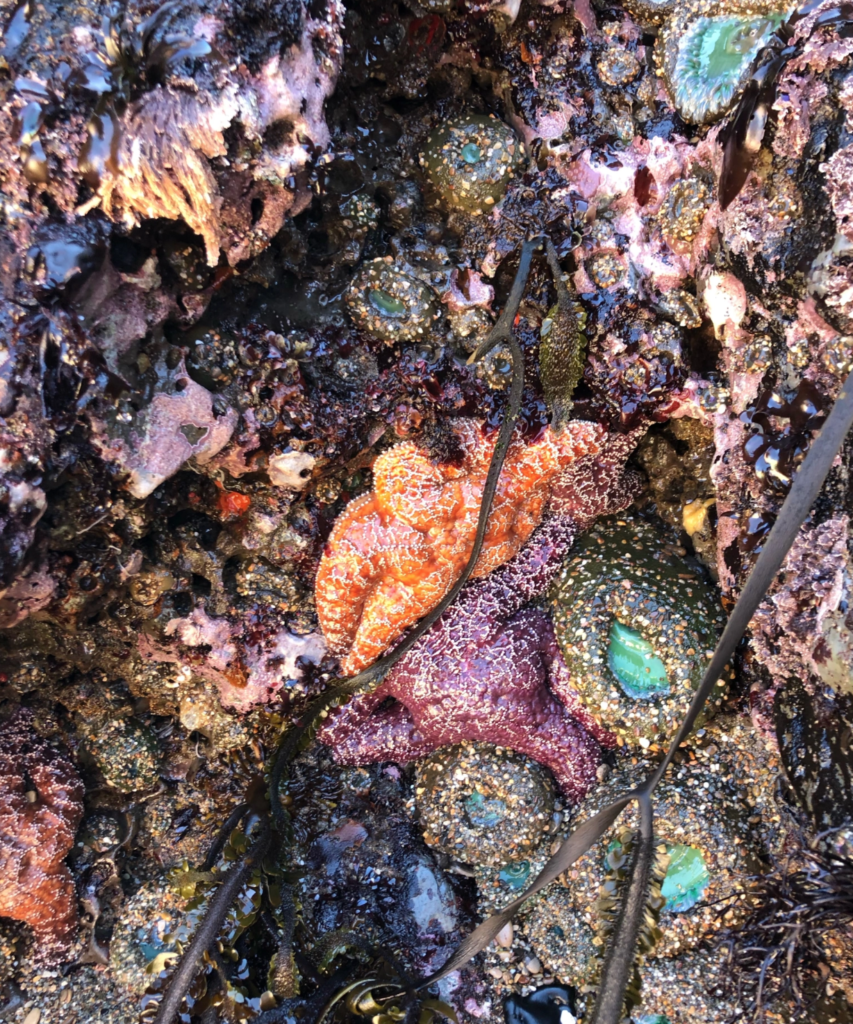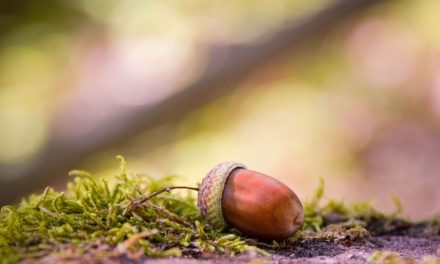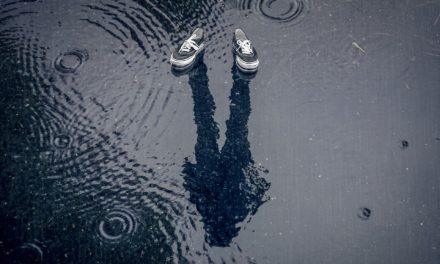The ocean retracted, leaving tidal pools and exposed rock. The secret of the rocks is that they are alive, covered in closed-shelled mussels, anemones, starfish, and urchins. The starfish– purple, orange– nestle together. Anemones spread out, clustered on rock, green mouths open.
When I close my eyes, I see a vast field that shimmers like the ocean where the sun glitters on the surface. Walking over the hills down to the water, it spreads out before us shining. There, everything is tender and quivering, a mirror to the field of my heart. So often closed tightly as a mussel, prickly as an urchin. I want to live as open as an anemone, one that slowly closes when tapped with a finger, but rests open, its mouth open to the world to receive what floats by.
Baby, I say, placing a hand on my chest, baby, and I know it is myself I am comforting as the animal of my body is soothed. The tickle of sorrow sends fluttering waves through it. Happiness is the bounce of ocean surf on the taut skin of the heart.
Out on the farther rocks where the ocean meets the tidal pools, the waves are slapping and rushing into the shallows. There are women with large black nets collecting urchins. Stepping on the mussels next to the waves, they carry knives in hand. Finding a purple spiked sphere, they pop it off the rock with the tip of the knife and place it in the bag.
I ask what they are doing and they show me the urchin, its dazzling shade of purple and its shameless spikes.

“Crack it open and eat it”, they say.
We break it open with the knife. Inside there is only softness. The shell is only a quarter-inch thick; the rest of the creature is soft and helpless. They show us how to scoop up its gonads and eat it in a single spoonful– the delicacy of uni.
The human heart can grow a shell, purple and spiky, but remains soft inside, just under the surface. Our softness can only take so much. When the heart meets with the unanswerable, the soft skin of its radiant responsive surface takes it in. What is a heart to do? The heart’s taut drum skin heart tries to hold the shock waves of the incomprehensible. It tries to hold what can be known only in obliteration. It wriggles and squirms. It shivers and snaps. The skin tears and when the water rushes through, the taut skin of its feeling drum collapses. I turn away when the feeling threatens obliteration. The ecosystem of the heart, too, has a need and a limit. We depend on human kindness.
The coral reefs are dying. The reefs are bleached. The habitat they create is extinguished. Oceans contain trash piles where birds choke with stomachs full of plastic. The seafloors are scraped into monochromatic uniformity.
I want to step out into the far tidal pools of the body, to find all the smallest morsels of soft heart skin hidden in the folds of the jagged rock. The pieces are there, toward the high waves, small spiky glimmers of radiant heart flesh that feels with the world. Plucked from the pools, it can be coaxed back to life, slowly at its own pace.
I want nothing more than to wade out and scoop with gentle hands the scraps of heart flesh buried there. Not to use it, or touch it, or enjoy it, or consume it, but to let the tender heart flesh express itself as gently and openly as the anemone. Just there, on the rocks, open to the waves that slam and caress it. It takes them in and is transformed.
It is here that life becomes more than a dream. That the coral reefs may never recover. That the poisoned heart, too, takes no less than all the time it needs to heal. That we must take care of every action to protect a human heart no less vulnerable than the sea and its billions of species. With its loss, we lose the oceans. We have only this one heart to save.








An exquisite essay. It is a great pity that it cannot simply be forwarded. It deserves to be
read by more people than those listed on Braided Way.
Miki, It can definitely be forwarded! We want to share this exquisite piece as well as those by every writer we publish. You’ll notice at the bottom of the post (before “About The Author”) there is a whole row of icons for Facebook, Twitter, Tumblr, Pinterest, email, etc. Please give sharing a try. And thank you for pointing this out, because I see our share options don’t include Instagram. We’ll look into that.